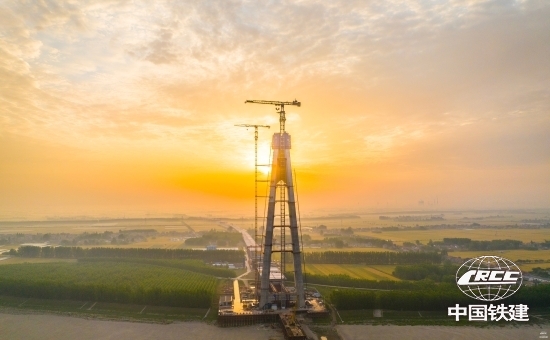 | Home | > News > Company News |
The main tower on the north bank of the Guanyinsi Yangtze River Bridge, the world’s longest-spanned highway cable-stayed bridge constructed by CRCC, was recently topped out in Hubei Province.
As a key control project of the Wuhan-Songzi Expressway, the Guanyinsi Yangtze River Bridge features a main bridge stretching 1,860 meters, with a central span of 1,160 meters and a 262-meter-tall north tower. The bridge holds five world records, including the longest span for a highway cable-stayed bridge and for a hybrid composite girder cable-stayed bridge. It is also the first in the world to use a hybrid steel-UHPC structure over a 1,000-meter span. Additionally, it features the largest-diameter friction pile group foundation, and the widest and heaviest precast sliding concrete girder segments constructed using the short-line match-casting method.
The construction team overcame challenging geological conditions and riverside construction obstacles by pioneering post-grouting technology in deep gravel layers, which substantially enhanced pile load-bearing capacity. During the Yangtze River's low-water season, they deployed seven ZJD-4000 drilling machines to successfully complete 44 piles constituting the world's largest friction pile group foundation. In an innovative approach to sustainability, the team converted temporary cofferdams into permanent flood protection structures, enhancing the overall safety integration between the bridge and riverbanks.
The tower construction showcased refined management practices and technological breakthroughs. Despite the complex diamond-shaped hexagonal cross-section with large chamfers, the team developed proprietary software for rapid steel reinforcement center of gravity calculations. They also implemented ground prefabrication and integral hoisting techniques that significantly improved precision and efficiency. For steel shell segment installation, the technical team enhanced the hydraulic climbing formwork system to achieve millimeter-precision connections, advancing standardized and intelligent construction methods.
The bridge is expected to be closed in the second half of 2026. Once completed, it will contribute to the development of China’s transportation infrastructure, enhancing the backbone road structure of the Yangtze River Economic Belt, improving the expressway layout in Hubei Province, and supporting the province’s coordinated regional development strategy.
